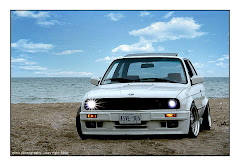
This Bulgarian teen by the name of Denislav Shishev is all set to make a good and addictive commitment with the BMW. So said since the last thing a person is ever likely to do is convert a broken down Z3 Coupe into a V10-packing pocket rocket without showing any love and affection for the Roundel.
When the car is equipped with the M5’s 10-cylinder engine which produces a quite impressive 442 hp of peak power, then this surely will be a substantial jump from the E30 M3 that he currently has to carry on with his track pursuits.
And if you think you too feel like trying something of this type yourself, you can check out the pictures below that should let you have an idea of the entire thing. Also, you should be in the mood to loosen your purse strings.
Source: carscoop
Friday, September 3, 2010
Teenage racer packs a BMW Z3 M Coupe with a V10
Thursday, September 2, 2010
Making of a milestone

By Samuel Ee
TWENTY-FIVE years after the first BMW M3 captivated boy racers and serious enthusiasts alike with its power and electric handling, the Munich-based carmaker marked this milestone at the Ascari race track in southern Spain. M is the motorsports division of BMW and for over a quarter of a century, it has produced four generations of the M3, which is based on the 3 Series.
As part of the celebrations, some pristine examples of these high-performance coupes and convertibles were taken out to be driven on and around Ascari.
The first M3 was built in 1985 for homologation purposes because BMW wanted to go racing. To enter the touring car series, it had to satisfy regulations that called for the production of at least 5,000 units. So the M3 was born.
A four-cylinder engine was created by lopping two cylinders off BMW's famed 2.0-litre straight-six unit. A four-pot was lighter and more suitable for competition, with a shorter crankshaft that did not vibrate at high revs.
The displacement was also expanded to 2.3 litres for more power.
But because the first M3 - codenamed the E30 - had an engine, transmission and suspension designed by race engineers, it was a road car that was built more like a race car. It also pioneered features like electronically adjustable dampers, with the driver able to choose from three settings using a knob on the lower centre console.
Little wonder then that it was a hit. The M3 E30 not only won admirers for its macho looks (thanks to flared wheel arches and big tail spoiler), but also championships across Europe. BMW's initial scepticism about being able to sell the 5,000 units quickly vanished and almost 18,000 were sold over its five-year production cycle.
Today, the original M3 still manages to electrify.
Around the Ascari circuit, it is wonderfully direct, with a mechanical rawness that can only be experienced in an era before electronics completely took over. With excellent balance and low weight (1,200kg), it is a joy to work its manual gearbox (with the dogleg first gear) around the smooth-flowing track.
But it requires more effort on the twisty mountain roads of the nearby Sierra de los Merinos. The steering is heavy and the engine strains to climb the inclines as briskly as a modern-day automobile.
The M3 E30 was replaced by the M3 E36 in 1992. The second-generation M3 was a completely new car, packing a 2.5-litre six-cylinder engine that had more power in line with customers' wishes.
Yet it was more refined with looks toned down by BMW board members who decided a less aggressive-looking car without spoilers was more appropriate. It was also available as a four-door saloon and this visual difference combined with the dynamic changes to make the jump from the first generation to the second generation extremely significant. All these made the new M3 seem like a big step in a different direction.
On the track, it still feels suitably contemporary and nimble, partly because its engine was later upgraded to a 3.2-litre straight six with double Vanos variable valve timing.
The SMG Sequential M Gearbox - the first to be offered by any manufacturer in the world - was also introduced.
In 2000, it was replaced by the third-generation M3 E46. It had a brand new 3,246cc six-cylinder engine with an impressive 343hp and 365Nm of torque - figures few naturally aspirated units could boast. Zero to 100kmh took just 5.2 seconds and the driver could choose from sporty or high-comfort engine response with the flick of a switch.
The second generation of the SMG transmission also debuted on this car and its Drivelogic feature offered a slew of gearshift programs as well as launch control for the optimum blast off.
But it was also bigger and heavier and on Ascari, its weight is discernible. However, it is also cultured and more comfortable, thus bringing a new level of refinement to the M3 lineage.
The M division made its biggest jump with the fourth-generation M3 though. The straight-six engine made way for a 4.0-litre V8 in 2007 and the car was clothed in sleek new styling.
With 420hp and a lightweight, largely aluminium chassis, it heralded the beginning of a new M era. Until the limited edition BMW M3 GTS arrives here early next year, that is.
This article was first published in The Business Times.

